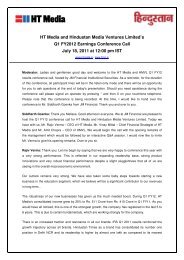Download latest annual report - HT Media
Download latest annual report - HT Media
Download latest annual report - HT Media
You also want an ePaper? Increase the reach of your titles
YUMPU automatically turns print PDFs into web optimized ePapers that Google loves.
Annual Report 2011-12<br />
52<br />
h) Borrowing costs<br />
Borrowing cost includes interest, amortization of<br />
ancillary costs incurred in connection with the<br />
arrangement of borrowings and exchange differences<br />
arising from foreign currency borrowings to the extent<br />
they are regarded as an adjustment to the interest cost.<br />
Borrowing costs directly attributable to the acquisition,<br />
construction or production of an asset that necessarily<br />
takes a substantial period of time to get ready for its<br />
intended use or sale are capitalized as part of the cost<br />
of the respective asset. All other borrowing costs are<br />
expensed in the period they occur.<br />
i) Impairment of tangible and intangible assets<br />
The Company assesses at each <strong>report</strong>ing date whether<br />
there is an indication that an asset may be impaired.<br />
If any indication exists, or when <strong>annual</strong> impairment<br />
testing for an asset is required, the Company estimates<br />
the asset’s recoverable amount. An asset’s recoverable<br />
amount is higher of an asset’s or it’s cash-generating<br />
unit’s (CGU) net selling price and its value in use. The<br />
recoverable amount is determined for an individual<br />
asset, unless the asset does not generate cash inflows<br />
that are largely independent of those from other assets<br />
or groups of assets. Where the carrying amount of<br />
an asset or CGU exceeds its recoverable amount,<br />
the asset is considered impaired and is written down<br />
to its recoverable amount. In assessing value in use,<br />
the estimated future cash flows are discounted to their<br />
present value using a pre-tax discount rate that reflects<br />
current market assessments of the time value of money<br />
and the risks specific to the asset. In determining net<br />
selling price, recent market transactions are taken into<br />
account, if available. If no such transactions can be<br />
identified, an appropriate valuation model is used.<br />
The Company bases its impairment calculation on<br />
detailed budgets and forecast calculations which are<br />
prepared separately for each of the Company’s cashgenerating<br />
units to which the individual assets are<br />
allocated. These budgets and forecast calculations are<br />
generally covering a period of five years. For longer<br />
periods, a long term growth rate is calculated and<br />
applied to project future cash flows after the fifth year.<br />
Impairment losses of continuing operations, including<br />
impairment on inventories, are recognized in the<br />
statement of Profit and Loss.<br />
After impairment, depreciation is provided on the<br />
revised carrying amount of the asset over its remaining<br />
useful life.<br />
j) Investments<br />
Investments, which are readily realizable and intended<br />
to be held for not more than one year from the date<br />
on which such investments are made, are classified as<br />
current investments. All other investments are classified<br />
as long-term investments.<br />
On initial recognition, all investments are measured at<br />
cost. The cost comprises purchase price and directly<br />
attributable acquisition charges such as brokerage,<br />
fees and duties. If an investment is acquired, or partly<br />
acquired, by the issue of shares or other securities, the<br />
acquisition cost is the fair value of the securities issued.<br />
Current investments are carried in the financial<br />
statements at lower of cost and fair value determined on<br />
an individual investment basis. Long-term investments<br />
are carried at cost. However, provision for diminution<br />
in value is made to recognize a decline other than<br />
temporary in the value of the investments.<br />
On disposal of an investment, the difference between<br />
its carrying amount and net disposal proceeds is<br />
charged or credited to the statement of Profit and Loss.<br />
Investment Property<br />
An investment in land or buildings, which is not<br />
intended to be occupied substantially for use by,<br />
or in the operations of, the company, is classified as<br />
investment property. Investment properties are stated<br />
at cost, net of accumulated depreciation & accumulated<br />
impairment losses, if any.<br />
The cost comprises purchase price, borrowing costs if<br />
capitalization criteria are met and directly attributable<br />
cost of bringing the investment property to its working<br />
condition for the intended use. Any trade discounts<br />
and rebates are deducted in arriving at the purchase<br />
price.<br />
Depreciation on building component of investment<br />
property is calculated on a straight-line basis using the<br />
rate arrived at based on useful life estimated by the<br />
management, or that prescribed under the Schedule<br />
XIV to the Companies Act, 1956, whichever is higher.<br />
The Company has used depreciation rate of 3.34%.<br />
On disposal of an investment property, the difference<br />
between it’s carrying amount and net disposal proceeds<br />
is charged or credited to the statement of Profit and Loss.<br />
k) Inventories<br />
Inventories are valued as follows:<br />
Raw materials, Lower of cost and net realizable value.<br />
stores and spares However, material and other items held<br />
for use in the production of inventories<br />
are not written down below cost if the<br />
finished products in which they will be<br />
incorporated are expected to be sold at<br />
or above cost. Cost is determined on a<br />
weighted average basis.<br />
Work-inprogress<br />
Scrap and Waste<br />
papers<br />
Lower of cost and net realizable value.<br />
Cost includes direct materials and a<br />
proportion of manufacturing overheads<br />
based on normal operating capacity.<br />
Cost is determined on a weighted<br />
average basis.<br />
At net realizable value.<br />
Net realizable value is the estimated selling price in the<br />
ordinary course of business, less estimated costs of<br />
completion and estimated costs necessary to make the sale.<br />
l) Revenue recognition<br />
Revenue is recognized to the extent that it is probable<br />
that the economic benefits will flow to the Company<br />
and the revenue can be reliably measured. Specifically,<br />
the following basis is adopted:<br />
Advertisements<br />
Revenue is recognized as and when advertisement is<br />
published/displayed and is disclosed net of discounts.





